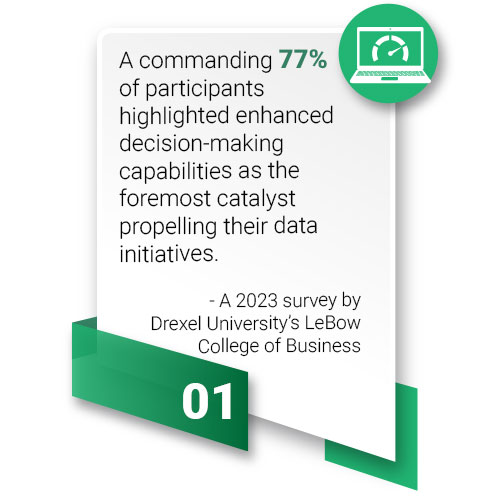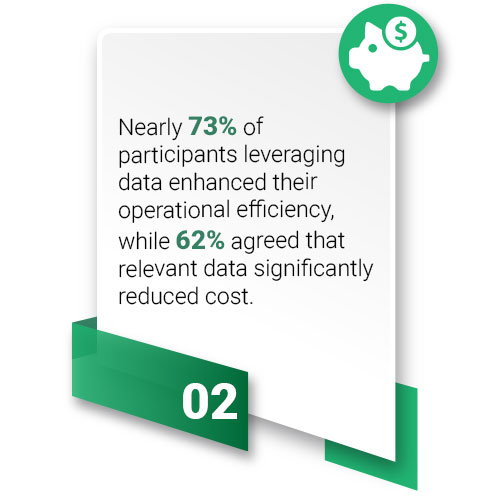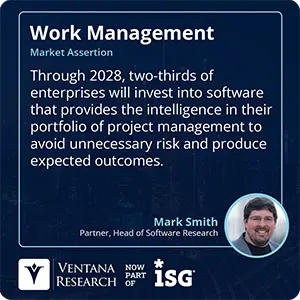
While the power of data is undeniable, the buzzwords "big data knows everything" and "data is the new oil" often overshadow the practical challenges faced by businesses when it comes to data-driven decision-making. Organizations of all sizes and across all industries can harness the power of information to guide informed choices. If your business is lagging in this crucial area, this article is for you. In this article, we will discuss the trends that set data-driven companies apart, the challenges of data-driven decision-making, and tips to build a data-driven business in 2024. The article also explores how you can leverage modern technology solutions like predictive intelligence for data-driven decision-making, especially for successful project execution.
Understanding Today’s Data-Driven Decision-Making
Gone are the days of intuitive business decisions. The current landscape demands a smarter, data-centric approach: data-driven decision-making. This powerful strategy leverages metrics and insights derived from data to inform crucial business decisions aligned with organizational goals and strategies. Business leaders often leverage business intelligence platforms to generate, share, and act upon data insights, frequently in the form of visualizations. This strategic approach utilizes the power of data analysis to make informed choices, act, and shape organizational strategies.
Businesses adopting data-driven decision-making can make more intelligent and informed choices, grounded not in instinct or experience alone but in the reality of past occurrences and the likelihood of their recurrence. Similarly, traditional project management methods often struggle to predict success. This is where predictive intelligence (PI) solutions play a critical role. Predictive analytics bring the future into focus, predicting project health and boosting outcomes with unparalleled clarity. This methodology has transformed how companies conduct business, facilitating faster, more cost-effective decisions with increased accuracy.
To illustrate this concept, consider the success of Uber, the prominent ride-hailing service, in overcoming business challenges and global regulatory changes. In response to the intricate and ever-changing landscape, Uber has embraced data-driven decision-making. The implementation of a bounded context system allowed them to define specific areas within their operations, such as managing users, handling trips, and processing payments. By organizing their software around these domains, Uber achieved the flexibility to adapt and scale each component independently, enabling swift responses to market dynamics and compliance with evolving regulatory requirements.
Emerging Trends that Shape Data-Driven Decision-Making
 As per a survey conducted in 2023 by Drexel University’s LeBow College of Business, a significant 77% of professionals specializing in data and analytics express that prioritizing data-driven decision-making stands as a key objective within their data programs. This indicates that today's data-driven landscape is undergoing a revolution, reshaping how you approach decision-making across industries. This transformation is further fueled by innovative trends that unlock the true potential of information, empower diverse stakeholders, and drive real-time intelligence.
As per a survey conducted in 2023 by Drexel University’s LeBow College of Business, a significant 77% of professionals specializing in data and analytics express that prioritizing data-driven decision-making stands as a key objective within their data programs. This indicates that today's data-driven landscape is undergoing a revolution, reshaping how you approach decision-making across industries. This transformation is further fueled by innovative trends that unlock the true potential of information, empower diverse stakeholders, and drive real-time intelligence.
Here are the top 7 trends propelling today’s data-driven decisions towards a brighter future:
- Hyper-Personalization: Hyper-personalization has replaced the outdated concept of one-size-fits-all. Businesses are leveraging customer data to craft bespoke experiences, recommendations, and services. By analyzing browsing history, preferences, and demographics, companies can create hyper-personalized offerings that enhance customer satisfaction, loyalty, and engagement. This level of granularity not only strengthens customer relationships but also enables data-driven decisions that address individual needs and exceed expectations.
- Cloud-Powered Agility: The shift to cloud-based data storage and processing is accelerating, offering
 remarkable scalability, flexibility, and cost-effectiveness compared to traditional on-premises solutions. Cloud platforms equip organizations with advanced analytics and machine-learning tools, empowering them to identify the full potential of their data. This translates to seamless collaboration, real-time access to insights, and the ability to process massive datasets at lightning speed. As data grows in volume and complexity, cloud-based solutions provide the agility and computational power needed for informed, data-driven choices.
remarkable scalability, flexibility, and cost-effectiveness compared to traditional on-premises solutions. Cloud platforms equip organizations with advanced analytics and machine-learning tools, empowering them to identify the full potential of their data. This translates to seamless collaboration, real-time access to insights, and the ability to process massive datasets at lightning speed. As data grows in volume and complexity, cloud-based solutions provide the agility and computational power needed for informed, data-driven choices. - Advanced Analytics Arsenal: By diving into historical and real-time information, advanced analytics techniques identify hidden risks, predict market shifts, and boost project success rates with unparalleled predictability of project outcomes and health. From optimizing operations to crafting exceptional customer experiences, businesses armed with actionable insights gain a decisive edge. It's not just about insights; it's about proactive decision-making for strategic advantage.
 Data Democratization for All: By democratizing data, teams gain access to a holistic view, enabling them to identify patterns, predict risks, and optimize strategies for successful project execution. This translates to reduced delays, minimized costs, and a clear roadmap to achieving desired project goals. Remember, data democratization is not just about access; it's about building a culture where data literacy is valued and encouraged.
Data Democratization for All: By democratizing data, teams gain access to a holistic view, enabling them to identify patterns, predict risks, and optimize strategies for successful project execution. This translates to reduced delays, minimized costs, and a clear roadmap to achieving desired project goals. Remember, data democratization is not just about access; it's about building a culture where data literacy is valued and encouraged.- Augmented Analytics: Intelligence Amplified: Augmented analytics leverages the power of AI and machine learning to streamline the data analysis process. It automates data preparation and predictive modeling and generates actionable insights, making data tasks more accessible to non-technical users. This approach accelerates the decision-making cycle, reduces human bias, and uncovers hidden patterns that lead to more informed, efficient, and strategic choices. Augmented analytics acts as a force multiplier, complementing human intelligence with machine-driven insights, ultimately revolutionizing how organizations utilize their data for decision-making.
- Edge Analytics: Decisions at the Source: Edge computing brings data processing and analysis closer to their origin, often on IoT devices or local servers. This approach minimizes the need to transmit large volumes of data to centralized hubs, significantly reducing latency, and enhancing real-time decision capabilities. Edge analytics is particularly critical in scenarios where immediate, context-aware decisions are imperative, such as autonomous vehicles, industrial IoT, or smart city infrastructure. It optimizes data collection, allows businesses to act on critical information faster, improves operational efficiency, and enables near-real-time responses to events.
- Artificial intelligence (AI): Previously, human intuition guided decision-making, often leading to subjective
 targeting, inaccurate project cost estimates, and risky business initiatives. AI transcends these limitations, offering unbiased analysis and real-time insights that illuminate the path to project success. AI excels at extracting meaningful patterns from data collections and building self-evolving models that predict project outcomes with remarkable accuracy. This real-time intelligence empowers businesses to make data-driven project decisions that outperform traditional methods. Additionally, its relentless learning capabilities, fueled by vast data streams, propel businesses towards a future of optimized operations and informed strategies.
targeting, inaccurate project cost estimates, and risky business initiatives. AI transcends these limitations, offering unbiased analysis and real-time insights that illuminate the path to project success. AI excels at extracting meaningful patterns from data collections and building self-evolving models that predict project outcomes with remarkable accuracy. This real-time intelligence empowers businesses to make data-driven project decisions that outperform traditional methods. Additionally, its relentless learning capabilities, fueled by vast data streams, propel businesses towards a future of optimized operations and informed strategies.
These trends represent a glimpse into the future of data-driven decision-making, where agility, intelligence, and collaboration converge to unlock unprecedented possibilities. By embracing these innovations, you can traverse the data deluge with confidence, gain a competitive edge, and deliver transformative experiences for your customers and stakeholders. While data-driven decision-making offers a powerful path to informed action, it's not without its hurdles. Let’s explore some of the challenges of data-driven decision-making here.
Data-Driven Decision-Making is Not Always Easy. Why?
While data-driven decision-making promises enhanced business processes, increased agility, improved customer service, and seamless project and product management, integrating it seamlessly presents significant hurdles. Here are some key challenges and potential solutions:
Data Quality and Reliability
Ensuring the quality and reliability of data is a pivotal challenge in data-driven decision-making. Flawed data, stemming from issues like incompleteness, inaccuracy, or biases, can significantly impact the conclusions and decisions drawn. The absence of standardized data formats, varying definitions, and inconsistencies in collection methods further compound this challenge.
Data Volume
The sheer volume of data generated, especially in projects, can be overwhelming. Extracting actionable insights to predict project health and outcome from this data overload demands the use of specialized tools and requires data management and analysis skills.
Data Integration
Integrating data from diverse systems and sources demands meticulous planning, compatibility checks, and robust data governance to achieve a unified and coherent dataset for analysis. Without these measures, organizations may face impediments in realizing the full potential of their data for informed decision-making.

Data Privacy and Security
Safeguarding data privacy and security stands out as a significant challenge. Adhering to stringent data protection regulations and implementing essential security measures is crucial to protecting sensitive data and ensuring the trust and confidence of both customers and stakeholders.
Talent and Skill Gap
A considerable talent and skills gap exists in the realm of data-driven decision-making. The demand for individuals proficient in data analysis, statistics, machine learning, and data visualization is escalating, yet the job market falls short of supplying an adequate pool of professionals with these capabilities.
Change Management
Shifting an organization's culture to embrace data-driven practices necessitates substantial changes in processes, workflows, and mindsets. Resistance to these changes and a lack of stakeholder buy-in can become other significant barriers. Addressing change management effectively is crucial to navigating the landscape of data-driven decision-making.
Bias and Fairness
The presence of bias and the pursuit of fairness are significant challenges in data-driven decision-making. Organizations must ensure that decision-making processes are unbiased and fair to avoid unintended consequences. Addressing these challenges requires a comprehensive approach that prioritizes ethical guidelines, workforce development, and the implementation of effective change management practices.
By addressing these challenges and implementing appropriate solutions, you, the business leaders, and project teams can leverage the power of data-driven decision-making to improve project outcomes and achieve greater success. So, how do you overcome these challenges and make better decisions? Let’s delve deeper into some of the ways in which you can master data-driven decision-making.
Effective Steps for Data-Driven Decision-Making
Achieving proficiency in data-driven decision-making requires a strategic approach. To enhance your leadership skills and transform raw data into actionable steps aligned with your company's objectives, consider the following steps:
 Clarify Your Vision
Clarify Your Vision
Before making informed decisions, it is imperative to comprehend your company's vision for the future. This understanding allows you to employ both data and strategy in shaping your decisions. Graphs and figures gain significance when anchored in the context of your company's yearly objectives, key results (OKRs), or quarterly team KPIs.
Ask Questions
Before applying modern technology solutions like AI to your projects and management practices, ask the following questions:
- Is your business data-rich and ready for AI-driven insights and decisions?
- Can AI automate repetitive tasks, freeing your team for high-value work?
- Do you have business challenges where AI could unlock innovation and efficiency?
- Do you want to personalize your customer experience and predict their needs with AI??
- Do you want to gain a competitive edge through AI-powered market analysis and strategy?
- Do you want to boost your project success rates with AI-based forecasting and optimization?
- Do you want to make faster, data-driven decisions with AI-powered analytics?
Answering "yes" to all these questions signals your readiness. If you have even one "no," address it before embarking on this pioneering journey.
Identify Data Sources
Once you've established the goal you're working towards, initiate the process of data collection. The choice of tools and data sources depends on the type of data you're collecting. Metrics such as gross profit margin, return on investment (ROI), productivity, total number of customers, and recurring revenue are essential indicators to measure success.
Organize Your Data
Organizing data is critical for effective visualization, a prerequisite for informed decision-making. Utilize an executive dashboard, often flexible and customizable, to display critical, real-time insights essential for achieving your project goals. This customizable interface enhances your ability to understand the interconnectedness of data and boosts project health and performance.

Conduct Data Analysis
With organized data, commence the process of data-driven analysis to extract actionable insights. Depending on your project goals, consider combining executive dashboard data with user research, such as case studies, surveys, or testimonials, to incorporate the customer experience. Share analytics tools with your team for diverse perspectives during collaborative data analysis.
Draw Conclusions
As you analyze data, draw conclusive insights to guide decision-making. Ask critical questions such as what you already knew about the data, what new information you've gained, and how the information can be leveraged to meet business goals and enhance your project's health and performance through predictive intelligence capabilities. Documenting specific, measurable, achievable, relevant, and time-bound (SMART) goals based on your findings is a natural next step in the data-driven decision-making process.
By following these steps, you can seamlessly integrate data-driven decision-making into your leadership practices and project execution processes, facilitating more informed and impactful choices for your business.
What’s the Way Ahead?
The transformative potential of data-driven decision-making is undeniable, offering businesses, regardless of their size, a pathway to enhanced efficiency, strategic advantage, and sustainable growth. While industry giants often dominate the narrative, the evolving landscape of data-driven practices in 2024 presents an opportunity for every organization, irrespective of size and industry, to bridge the gap and harness the power of information.
The trends shaping data-driven decision-making, such as hyper-personalization, cloud-powered agility, advanced analytics, data democratization, augmented analytics, edge analytics, and artificial intelligence, are not mere buzzwords but key enablers of a more intelligent and collaborative future. Right from the ground up, where projects stand as the building blocks of every initiative and function, these trends open the door for a vast number of opportunities, empowering organizations to navigate the complexities of a data-driven world with confidence. This data-driven approach empowers project teams to overcome complexities, deliver impactful results, boost project health and performance, and ultimately drive organizational success.
 If you are a business leader or a project leader seeking to master data-driven decision-making, TrueProject, a predictive intelligence solution for project health and performance, is a perfect match. It’s 360-degree view based on soft and hard data, flexible and interactive dashboards, and accurate status of your project’s health and performance enable you to implement preventive measures and safeguards, reducing the likelihood of failing projects. TrueProject, a predictive intelligence and AI-powered solution, collects, analyzes, and presents insights automatically, so your project leaders can focus on successfully executing projects. This solution goes beyond conventional analytics, uncovering derived wisdom to empower smarter decision-making, thus significantly boosting your project outcomes. Additionally, TrueProject’s insights help you experience strategic clarity like never before, as they guide you towards informed decisions that shape the future of your enterprise. Be the catalyst for change and efficiency with TrueProject as your trusted partner.
If you are a business leader or a project leader seeking to master data-driven decision-making, TrueProject, a predictive intelligence solution for project health and performance, is a perfect match. It’s 360-degree view based on soft and hard data, flexible and interactive dashboards, and accurate status of your project’s health and performance enable you to implement preventive measures and safeguards, reducing the likelihood of failing projects. TrueProject, a predictive intelligence and AI-powered solution, collects, analyzes, and presents insights automatically, so your project leaders can focus on successfully executing projects. This solution goes beyond conventional analytics, uncovering derived wisdom to empower smarter decision-making, thus significantly boosting your project outcomes. Additionally, TrueProject’s insights help you experience strategic clarity like never before, as they guide you towards informed decisions that shape the future of your enterprise. Be the catalyst for change and efficiency with TrueProject as your trusted partner.
The power of data is for everyone to explore and embrace. It's a solution that, when wielded strategically, can empower you, irrespective of your business’ size, to thrive and innovate in the competitive landscape of 2024.
More on TrueProject at www.trueprojectinsight.com.
 About the Author:
About the Author:
Serving as the CEO at TrueProject, Tom Villani plays a major role in shaping the company's strategic direction, driving growth, and fostering a culture of innovation. Prior to his role at TrueProject, Tom worked as the Senior Vice President, Digital Innovation at CAI, Vice President of Global Alliances and Partners at Hitachi Vantara, and key senior executive roles with Information Builders, MicroStrategy and AT&T. Tom also serves in advisory board capacities in the areas of Big Data and IoT.
Endnotes:
- Neville, Ashley Howard. “5 Trends That Set Data-Driven Companies Apart.” Forbes, July 6, 2021. https://www.forbes.com/sites/tableau/2021/07/06/5-trends-that-set-data-driven-companies-apart/?sh=2dce3a867679
- “Data-Driven Decision-Making in Project Management.” Atlassian, September 17, 2023. https://community.atlassian.com/t5/Atlassian-Platform-articles/Data-Driven-Decision-Making-in-Project-Management/ba-p/2479640#:~:text=Data%2Ddriven%20decision%2Dmaking%20in%20project%20management%20represents%20a%20transformational,the%20outcomes%20of%20their%20projects
- “The Role of Technology in Making Data-Driven Strategic Decisions.” Precisely, January 23, 2024. https://www.precisely.com/blog/datagovernance/data-driven-strategic-decisions
- “Data-driven decision making: A step-by-step guide.” Asana, October 03, 2022. https://asana.com/resources/data-driven-decision-making
- John. “The Trends & Challenges in Data Driven Decision Making.” Phygital Insights, November 24, 2023. https://www.phygital-insights.com/blog/challenges-in-data-driven-decision-making
- Smilansky, Vika. “Data-driven decision making: How to use data to make more informed decisions.” ThoughtSpot, April 20, 2023. https://www.thoughtspot.com/data-trends/best-practices/data-driven-decision-making
- Krastev, Ned. “How to Build a Data-Driven Business in 2024.” 365 Data Science, January 16, 2024. https://365datascience.com/trending/how-to-build-a-data-driven-business/
- Venkatesh R Kishor. “Leverage Sales Intelligence for Data-Driven Decision-Making in 2024.” Draup, January 11, 2024. https://draup.com/sales/blog/leverage-sales-intelligence-for-data-driven-decision-making-in-2024/
- Nieto-Rodriguez, Antonio; Vargas, Ricardo Viana. “How AI Will Transform Project Management.” Harvard Business Review, February 02, 2023. https://hbr.org/2023/02/how-ai-will-transform-project-management




